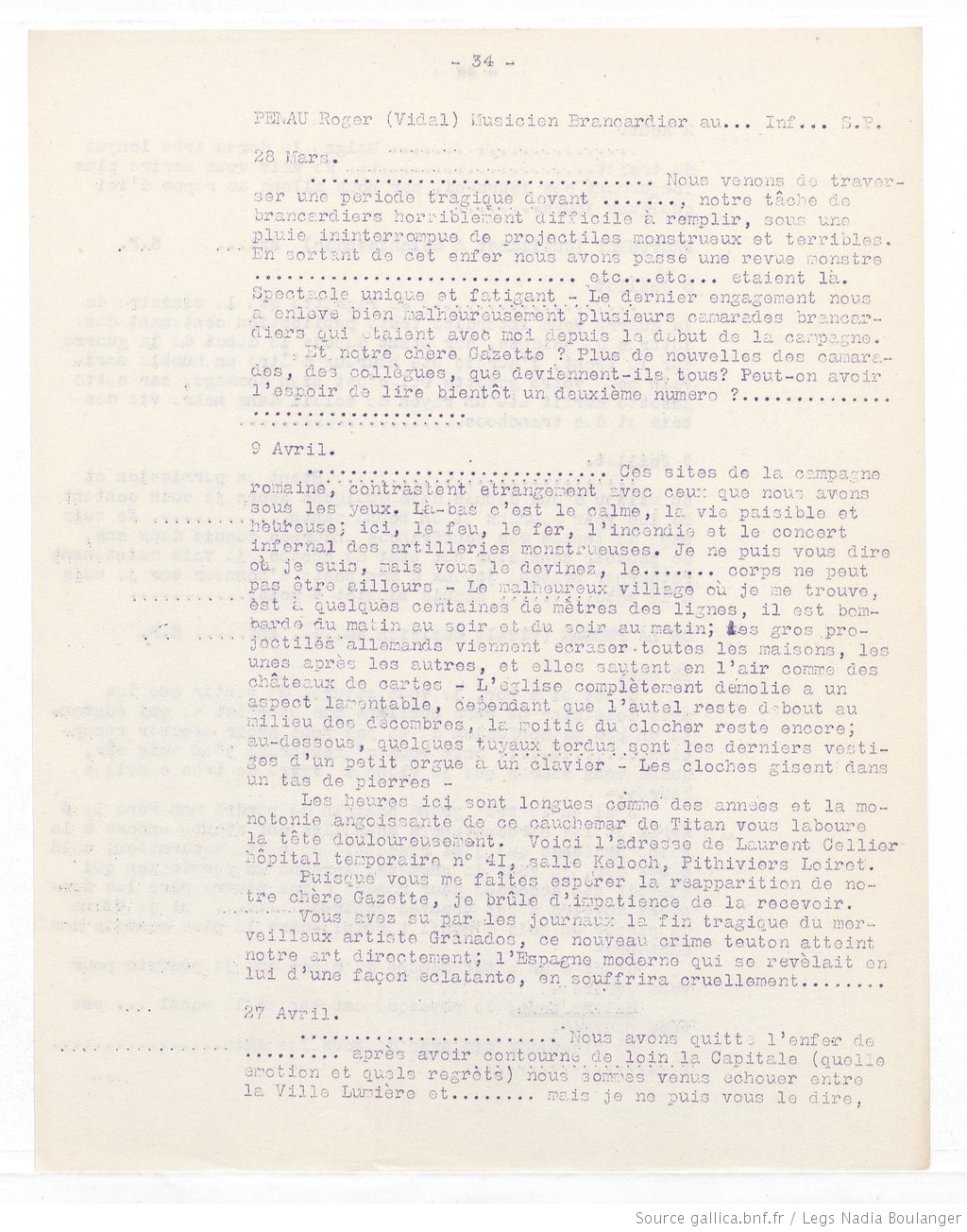Paris-Manchester 1918
Conservatoires in time of war
Daily life of the musician-stretcher-bearer
The conscripts tell of their weariness after a year and a half of unceasing war. The first paragraph of the letter of 28 March 1916 is a point-by-point reply to the customary criticisms of musician-stretcher-bearers: in fact they are not soldiers and do not carry weapons. Their role is to go over the top between one attack and the next to retrieve the wounded. However, they are not considered medical personnel, and the fact that they do not wear armbands with a red cross makes them targets for enemy fire.
The letter of 9 April provides information about life at the front: “the infernal concert of artillery pieces” has replaced the concerts of the Conservatoire. Roger Pénau, being a musician, even breaks into lyrical expression when he contemplates the organ of the church in the village where his company is based. Similar accounts occur repeatedly in the Gazette des classes du Conservatoire.
Translation
PENAU Roger (Vidal[1]), musician-stretcher-bearer at . . . inf[2] . . . S.P.[3]
28 March
. . . . . . . . . . . . . . . . . . . . . . We have just come through a tragic period in which . . . . . . . we did our work as stretcher-bearers – horribly difficult – as monstrous, terrible shells rained down on us non-stop. When we got out of that hell, we had to go through a massive review. . . . . . . . . . . . . . . . . . . . . . . . etc., etc. were there. It was a unique spectacle, and a tiring one. The last fighting unfortunately claimed the lives of several comrades, stretcher-bearers who had been with me since the start of the campaign.
And our dear Gazette? No more news of our comrades and colleagues? What are they all doing? Is there any chance of seeing a second issue soon? . . . . . . . . . . . . . . . . . . . . . . . . . . . . . . . . . .
9 April
. . . . . . . . . . . . . . . . . . . . . . . . . . . . Those parts of the Roman countryside contrast strangely with the ones here right in front of us. Down there all is calm, life is peaceful and happy; here are fire and iron, flames and the infernal concert of monstrous artillery pieces. I cannot tell you where I am, but you will guess – the . . . . . . Corps cannot be anywhere else. The unfortunate village where I am now is a few hundred yards from the lines; it is bombarded from morning till night and from night till morning. The big German shells come crashing down on all the houses, one after another, and they fly up in the air as if they were made of cards. The demolished church is a sorrowful sight, with its altar still standing amid the rubble; underneath the remaining half of its steeple are a few twisted pipes – all that is left of a little keyboard organ; the bells lie in a heap of stones.
The hours here are as long as years and the harrowing monotony of this vast nightmare torments one’s mind. Here is Laurent Cellier’s[4] address: Temporary Hospital No.41, Keloch Room, Pithiviers, Loiret.
Since you have given me hope of seeing our dear Gazette once more, I can barely stand waiting to receive it.
You will have read in the newspapers about the tragic death of the wonderful artist Enrique Granados[5] – another German crime directly against our art; this will be a cruel loss to modern Spain, which he revealed to our eyes in such a dazzling manner. . . . . . .
[1]Paul Vidal (1863-1931), teacher of music theory, accompaniment and composition at the Paris Conservatoire.
[2]Roger Pénau was with 160th infantry regiment at this time.
[3]Secteur postal [postal sector].
[4]Laurent Ceillier (1887-1925), composer and musicologist.
[5]Enrique Granados (1867-1916) was killed on the liner SS Sussex when it was torpedoed by a German U-boat.
Source
Roger Pénau (28 March 1916) Letter to the Franco-American Committee, in: Gazette des classes du Conservatoire, No. 3, Paris, October 1916, Bibliothèque nationale de France, Music Department, Rés Vm Dos 88 (1), p. 34. View on Gallica.
Roger Pénau (9 April 1916) Letter to the Franco-American Committee, in: Gazette des classes de composition du Conservatoire, No. 3. Paris, October 1916, Bibliothèque nationale de France, Music Department, Rés Vm Dos 88- (1), p. 34 [on line].
Document description: roneoed document in violet ink, 21×27 cm.




